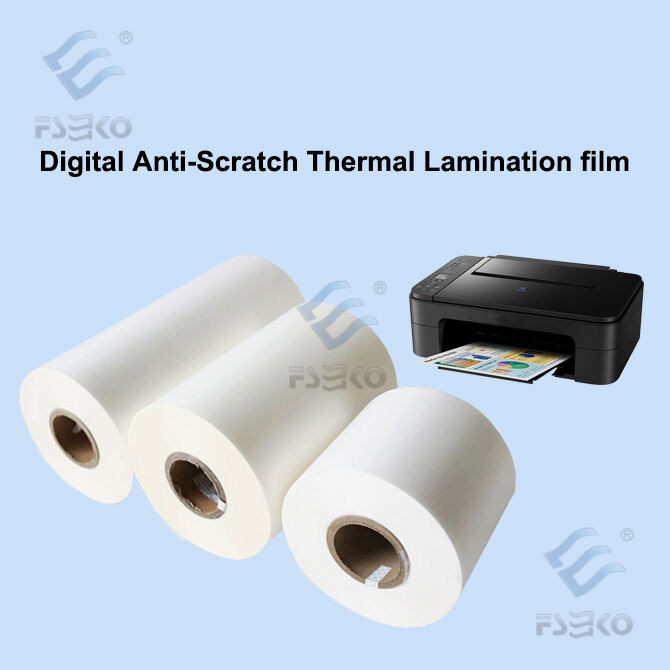What Is Digital Anti-Scratch Thermal Lamination Film?
Core Features of Anti-Scratch Films
Digital anti-scratch thermal lamination film is specially crafted to significantly boost the durability of surfaces, protecting them against scratches, wear, and tear. These films incorporate a unique coating that enhances scratch resistance, ensuring the longevity of the material's aesthetic appeal. Often featuring a striking high gloss or matte finish, anti-scratch films not only safeguard the printed surfaces but also elevate their visual quality, making them ideal for various applications.
Why Scratch Resistance Matters in Lamination
Scratch resistance is essential to preserving the integrity of printed graphics, particularly in environments with frequent handling and high traffic. Studies indicate that materials laminated with effective scratch-resistant films can endure up to 50% longer than those without, therefore decreasing the need for replacements. This enhanced durability leads to significant cost savings, as businesses can minimize expenses related to frequent reprints and replacements, underscoring the importance of scratch-resistant lamination in commercial settings.
Key Applications of Thermal Lamination Films
Protecting Printed Materials in Publishing
Thermal lamination films are extensively used to protect printed materials within the publishing industry. These films provide a protective layer that enhances the lifespan of magazines, brochures, and books by shielding them from damage. Notably, lamination prevents moisture, dirt, and fingerprints from compromising the quality, ensuring that these products remain appealing to consumers. Furthermore, the lamination process enhances color vibrancy and contrast, producing eye-catching text and images.
Enhancing Durability in Packaging Design
In packaging design, thermal lamination plays a crucial role in boosting product durability and extending shelf life. By providing a robust barrier against physical damage and environmental factors, lamination ensures that packaging remains intact during transportation and storage. Laminated packaging not only safeguards the contents but also enhances the box design, thereby improving brand visibility and appeal.
Specialized Uses in Electronics & Displays
Thermal lamination films are prominently used in electronics, particularly in protecting sensitive surfaces of electronic displays from scratches and moisture. These films can enhance screen clarity and responsiveness, making them suitable for touch devices and monitors. Additionally, applying thermal lamination in electronics packaging offers a sturdy barrier, ensuring products are shielded from potential damage during transit.
BOPP vs PET Film: Material Comparison
Strength & Flexibility Differences
When comparing BOPP and PET films, one must consider their unique properties. BOPP (Biaxially Oriented Polypropylene) films are celebrated for their high tensile strength and flexibility, making them well-suited for applications where bending and movement are frequent. This strength enables the film to withstand substantial stress without tearing, ideal for dynamic environments. On the other hand, PET (Polyethylene Terephthalate) films excel in providing exceptional dimensional stability and rigidity, a necessity in demanding conditions that require maintaining form and structure under pressure. Businesses can make informed decisions by understanding these differences in strength and flexibility, ensuring they choose the appropriate material for their specific application needs.
Heat Resistance & Clarity Factors
The comparison of BOPP and PET films should also address heat resistance and clarity. PET films stand out with their superior heat resistance, making them suitable for applications involving high temperatures where other materials might warp or degrade. This robust resistance is beneficial for environments that demand consistent performance despite temperature changes. Furthermore, PET films offer outstanding clarity and transparency, ensuring that graphics and text remain crisp and vibrant. These features make PET a popular choice for products that not only demand durability but also highlight aesthetic appeal. For businesses prioritizing keen visual presentation along with resilience, PET films are a top choice.
Critical Features to Evaluate
Optimal Thickness for Different Projects (1.2-1.5 mil)
Choosing the right thickness for thermal lamination film is essential for ensuring optimal performance and protection. Typically, a thickness between 1.2 to 1.5 mil is recommended for most general applications. This range offers a balanced combination of durability and flexibility, accommodating a variety of materials without compromising their integrity. While thicker films provide enhanced protection, they may lack flexibility, making them less suitable for delicate materials. Conversely, thinner films cater more effectively to lightweight or intricate substrates. By carefully assessing the specific needs of each project, one can determine the most appropriate film thickness, ensuring the best results for the intended application.
Adhesive Quality & Bubble Prevention
Adhesive quality is a critical factor in the effectiveness of thermal lamination films. The bond strength between the film and the substrate plays a significant role in the laminate's long-term durability and visual quality. High-quality adhesives enhance this bond, reducing the occurrence of bubbles and imperfections during application. This results in a smoother, more professional finish. Evaluating the adhesive properties as indicated by manufacturer specifications can guide the selection process, ensuring that the chosen film meets project standards for both appearance and performance. Prioritizing adhesive quality is crucial for achieving a bubble-free lamination that stands the test of time.
UV Protection & Yellowing Resistance
UV protection is another vital feature of many thermal lamination films, particularly for projects exposed to sunlight. Films equipped with UV blocking capabilities help mitigate color fading, preserving the visual fidelity of laminated materials. For outdoor applications, this feature becomes indispensable, safeguarding documents, signs, or photos from sunlight damage. Similarly, resistance to yellowing ensures that the materials maintain their intended appearance over time, resisting the natural ageing process that can compromise aesthetics. Selecting films specifically engineered for UV protection and yellowing resistance ensures longevity and protects the integrity of the laminated items effectively.
Cost vs Value Analysis: Is It Worth Investing?
Long-Term Protection vs Replacement Costs
Investing in high-quality thermal lamination films can be a financially savvy choice for businesses looking to reduce long-term replacement costs. While the initial spending might appear steep, the enhanced durability and lifespan of laminated materials often translate into significant savings over time. For instance, reduced wear and tear mean fewer reprints and replacements, saving both money and resources. Understanding this cost-versus-value equation is essential for businesses to make informed decisions regarding their lamination needs.
EKO's 19-Year Quality Assurance Advantage
Choosing EKO thermal lamination films comes with the benefit of a 19-year quality assurance, which underscores the company's commitment to providing reliable and long-lasting products. This guarantee ensures that customers can expect consistent performance over time, leading to fewer replacements and increased satisfaction. When assessing the value of an investment in lamination films, evaluating such product warranties offers insight into the product's long-term reliability and economic benefits.
Environmental Benefits of Durable Lamination
The environmental impact of durable thermal lamination films is another compelling reason to invest in this technology. By extending the lifecycle of print and packaging materials, these films help minimize waste and reduce the frequency of reprints and replacements. Such sustainability aspects align with growing consumer preferences for eco-friendly practices, making it a strategic consideration for businesses aiming to enhance their environmental responsibility. Understanding these benefits is key as brands increasingly strive to adopt greener initiatives.


